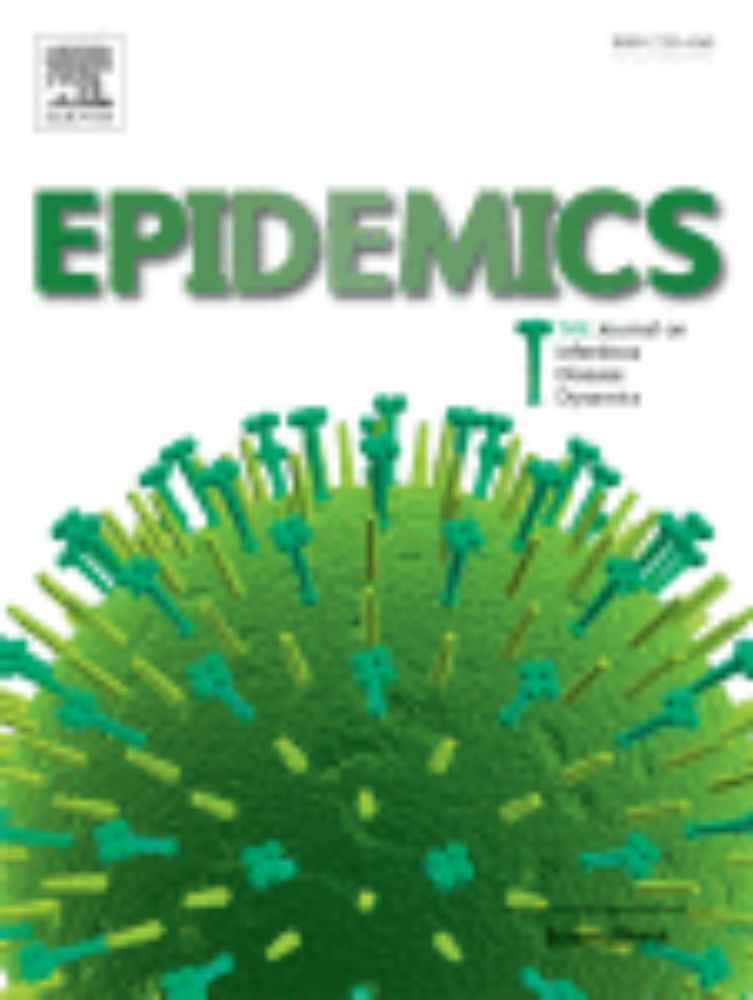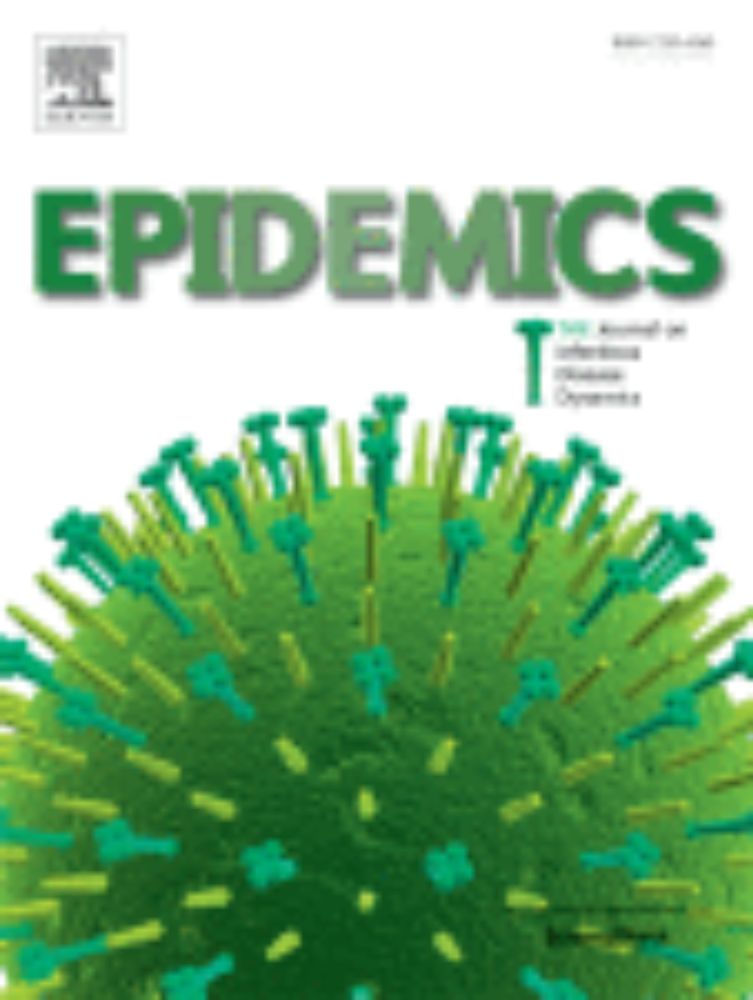James Hay
@jameshay.bsky.social
Research Fellow at the Pandemic Sciences Institute, University of Oxford. Using maths and stats to understand infectious disease dynamics, mostly viral kinetics and serology. https://hay-idd.github.io/
Reposted by James Hay
🚨 New paper out in PLOS Computational Biology! 🚨
We're excited to share our new paper, serojump, a new probabilistic framework and R package for inferring infections and antibody kinetics from longitudinal serological data.
📄 Full paper: tinyurl.com/re7du3t2
R package: seroanalytics.org/serojump
We're excited to share our new paper, serojump, a new probabilistic framework and R package for inferring infections and antibody kinetics from longitudinal serological data.
📄 Full paper: tinyurl.com/re7du3t2
R package: seroanalytics.org/serojump
A serological inference package using reversible jump mcmc
The `serojump` package provides tools for fitting serological models to antibody kinetics data using reversible-jump Markov Chain Monte Carlo (RJ-MCMC). It enables researchers to model the dynamics of...
seroanalytics.org
September 23, 2025 at 12:36 PM
🚨 New paper out in PLOS Computational Biology! 🚨
We're excited to share our new paper, serojump, a new probabilistic framework and R package for inferring infections and antibody kinetics from longitudinal serological data.
📄 Full paper: tinyurl.com/re7du3t2
R package: seroanalytics.org/serojump
We're excited to share our new paper, serojump, a new probabilistic framework and R package for inferring infections and antibody kinetics from longitudinal serological data.
📄 Full paper: tinyurl.com/re7du3t2
R package: seroanalytics.org/serojump
Closing date tomorrow!
We're hiring a modelling postdoc at PSI Oxford for two exciting projects: 1) modelling the early immune responses to Nipah vaccination, and 2) joining the PRESTO team working on immunobridging in vaccine evaluation studies.
tinyurl.com/5abbxrjh
Get in touch for more info! Deadline 4th August.
tinyurl.com/5abbxrjh
Get in touch for more info! Deadline 4th August.
Job Details
tinyurl.com
August 3, 2025 at 6:24 AM
Closing date tomorrow!
Reposted by James Hay
Excited to share our paper on viral load dynamics of West Nile virus in mosquitoes! Key findings:
1. Variation in pooled Ct values from mosquito traps reflect underlying biological and epidemiological mechanisms.
2. WNV prevalence estimates are improved by using Cts rather than +ve/-ve pool status.
1. Variation in pooled Ct values from mosquito traps reflect underlying biological and epidemiological mechanisms.
2. WNV prevalence estimates are improved by using Cts rather than +ve/-ve pool status.
New preprint!
We use pooled Ct values from mosquito surveillance to estimate West Nile virus prevalence—without binarising the data.
Joint work with Ian Marchinton, Joseph R. Fauver & James Hay.
Check it out: www.biorxiv.org/content/10.1...
We use pooled Ct values from mosquito surveillance to estimate West Nile virus prevalence—without binarising the data.
Joint work with Ian Marchinton, Joseph R. Fauver & James Hay.
Check it out: www.biorxiv.org/content/10.1...
Tracking West Nile virus dynamics using viral loads from trapped mosquitoes
West Nile virus (WNV) persists in an enzootic cycle between birds and mosquitoes. Human infections are incidental and usually sub-clinical with some cases of neuroinvasive disease. Mitigation relies on surveillance to guide decision making, including RT-qPCR testing pools of mosquitoes. Cycle threshold (Ct) values from these pools\---|semi-quantitative proxies for viral load\---|are binarised to estimate WNV prevalence in mosquitoes as a proxy for human risk. We showed that Ct value variation in Colorado and Nebraska (2022-2024) cannot be explained by laboratory factors, suggesting a role for biological and epidemiological mechanisms. We developed a multiscale model linking pooled Ct values to mosquito viral kinetics, bird-to-mosquito transmission, and seasonal force of infection. A novel method estimating WNV prevalence using pooled Ct values outperformed existing approaches at high prevalence. We demonstrate the importance of treating environmental viral load samples as quantitative, as binarising masks key information for arbovirus surveillance and risk mitigation. ### Competing Interest Statement The authors have declared no competing interest. Wellcome Trust Early Career Award, grant 225001/Z/22/Z UNMC VCR
www.biorxiv.org
July 7, 2025 at 9:13 AM
Excited to share our paper on viral load dynamics of West Nile virus in mosquitoes! Key findings:
1. Variation in pooled Ct values from mosquito traps reflect underlying biological and epidemiological mechanisms.
2. WNV prevalence estimates are improved by using Cts rather than +ve/-ve pool status.
1. Variation in pooled Ct values from mosquito traps reflect underlying biological and epidemiological mechanisms.
2. WNV prevalence estimates are improved by using Cts rather than +ve/-ve pool status.
We're hiring a modelling postdoc at PSI Oxford for two exciting projects: 1) modelling the early immune responses to Nipah vaccination, and 2) joining the PRESTO team working on immunobridging in vaccine evaluation studies.
tinyurl.com/5abbxrjh
Get in touch for more info! Deadline 4th August.
tinyurl.com/5abbxrjh
Get in touch for more info! Deadline 4th August.
Job Details
tinyurl.com
July 11, 2025 at 11:32 AM
We're hiring a modelling postdoc at PSI Oxford for two exciting projects: 1) modelling the early immune responses to Nipah vaccination, and 2) joining the PRESTO team working on immunobridging in vaccine evaluation studies.
tinyurl.com/5abbxrjh
Get in touch for more info! Deadline 4th August.
tinyurl.com/5abbxrjh
Get in touch for more info! Deadline 4th August.
Excited to share our paper on viral load dynamics of West Nile virus in mosquitoes! Key findings:
1. Variation in pooled Ct values from mosquito traps reflect underlying biological and epidemiological mechanisms.
2. WNV prevalence estimates are improved by using Cts rather than +ve/-ve pool status.
1. Variation in pooled Ct values from mosquito traps reflect underlying biological and epidemiological mechanisms.
2. WNV prevalence estimates are improved by using Cts rather than +ve/-ve pool status.
New preprint!
We use pooled Ct values from mosquito surveillance to estimate West Nile virus prevalence—without binarising the data.
Joint work with Ian Marchinton, Joseph R. Fauver & James Hay.
Check it out: www.biorxiv.org/content/10.1...
We use pooled Ct values from mosquito surveillance to estimate West Nile virus prevalence—without binarising the data.
Joint work with Ian Marchinton, Joseph R. Fauver & James Hay.
Check it out: www.biorxiv.org/content/10.1...
Tracking West Nile virus dynamics using viral loads from trapped mosquitoes
West Nile virus (WNV) persists in an enzootic cycle between birds and mosquitoes. Human infections are incidental and usually sub-clinical with some cases of neuroinvasive disease. Mitigation relies on surveillance to guide decision making, including RT-qPCR testing pools of mosquitoes. Cycle threshold (Ct) values from these pools\---|semi-quantitative proxies for viral load\---|are binarised to estimate WNV prevalence in mosquitoes as a proxy for human risk. We showed that Ct value variation in Colorado and Nebraska (2022-2024) cannot be explained by laboratory factors, suggesting a role for biological and epidemiological mechanisms. We developed a multiscale model linking pooled Ct values to mosquito viral kinetics, bird-to-mosquito transmission, and seasonal force of infection. A novel method estimating WNV prevalence using pooled Ct values outperformed existing approaches at high prevalence. We demonstrate the importance of treating environmental viral load samples as quantitative, as binarising masks key information for arbovirus surveillance and risk mitigation. ### Competing Interest Statement The authors have declared no competing interest. Wellcome Trust Early Career Award, grant 225001/Z/22/Z UNMC VCR
www.biorxiv.org
July 7, 2025 at 9:13 AM
Excited to share our paper on viral load dynamics of West Nile virus in mosquitoes! Key findings:
1. Variation in pooled Ct values from mosquito traps reflect underlying biological and epidemiological mechanisms.
2. WNV prevalence estimates are improved by using Cts rather than +ve/-ve pool status.
1. Variation in pooled Ct values from mosquito traps reflect underlying biological and epidemiological mechanisms.
2. WNV prevalence estimates are improved by using Cts rather than +ve/-ve pool status.
Reposted by James Hay
Our latest paper www.sciencedirect.com/science/arti... shows that mass PCR testing could control a range of potential respiratory pandemics at low societal cost. We also explore logistics. Even a prototype would be really nice now with H5N1. @jameshay.bsky.social 1/9

Enhanced testing can substantially improve defense against several types of respiratory virus pandemic
Mass testing to identify and isolate infected individuals is a promising approach for reducing harm from the next acute respiratory virus pandemic. It…
www.sciencedirect.com
February 7, 2025 at 10:42 PM
Our latest paper www.sciencedirect.com/science/arti... shows that mass PCR testing could control a range of potential respiratory pandemics at low societal cost. We also explore logistics. Even a prototype would be really nice now with H5N1. @jameshay.bsky.social 1/9
Reposted by James Hay
Two postdoc positions to work on virus epi & evolution in response to vaccination, with both theoretical models + data analysis. Paris/Montpellier. With Sylvain Gandon, Sébastien Lion, François Blanquart, Katrina Lythgoe, & Troy Day
emploi.cnrs.fr/Offres/CDD/U...
emploi.cnrs.fr/Offres/CDD/U...
emploi.cnrs.fr/Offres/CDD/U...
emploi.cnrs.fr/Offres/CDD/U...
Portail Emploi CNRS - Offre d'emploi - Chercheur.e postdoctoral H/F en épidémiologie évolutive
emploi.cnrs.fr
January 30, 2025 at 10:11 AM
Two postdoc positions to work on virus epi & evolution in response to vaccination, with both theoretical models + data analysis. Paris/Montpellier. With Sylvain Gandon, Sébastien Lion, François Blanquart, Katrina Lythgoe, & Troy Day
emploi.cnrs.fr/Offres/CDD/U...
emploi.cnrs.fr/Offres/CDD/U...
emploi.cnrs.fr/Offres/CDD/U...
emploi.cnrs.fr/Offres/CDD/U...
Reposted by James Hay
Please spread the word - a funded (home fees) DPhil (PhD) studentship available in @oxfordstatistics.bsky.social
Social optimisation of public-facing digital tools for health protection and trial frameworks for non-pharmaceutical interventions
www.stats.ox.ac.uk/research-stu...
Social optimisation of public-facing digital tools for health protection and trial frameworks for non-pharmaceutical interventions
www.stats.ox.ac.uk/research-stu...
Research Studentships | statistics
www.stats.ox.ac.uk
January 28, 2025 at 7:55 PM
Please spread the word - a funded (home fees) DPhil (PhD) studentship available in @oxfordstatistics.bsky.social
Social optimisation of public-facing digital tools for health protection and trial frameworks for non-pharmaceutical interventions
www.stats.ox.ac.uk/research-stu...
Social optimisation of public-facing digital tools for health protection and trial frameworks for non-pharmaceutical interventions
www.stats.ox.ac.uk/research-stu...
Hello influenza enthusiasts! You may be interested in our recent publication linked below. We used multi-strain serology to figure out who got infected with which A/H3N2 influenza strain and when, allowing us to reconstruct epidemiological patterns back to 1968 stratified by time, age and location.
Reconstructed influenza A/H3N2 infection histories using multistrain serology, paper out in PLOS Biology plos.io/3YIDQpt! We inferred lifetime infections and antibody levels for 1130 individuals in Guangzhou, China, giving insights into long-term influenza incidence and immunity.
Thread below:
Thread below:
January 8, 2025 at 6:30 AM
Hello influenza enthusiasts! You may be interested in our recent publication linked below. We used multi-strain serology to figure out who got infected with which A/H3N2 influenza strain and when, allowing us to reconstruct epidemiological patterns back to 1968 stratified by time, age and location.
Reposted by James Hay
Are you interested in analysing serological data for infectious disease epidemiology? Check out our new review article on serodynamics! With Saki Takahashi at JHU and Isobel Routledge at UCSF. (See next comment if you're into serology modeling) www.sciencedirect.com/science/arti...

Serodynamics: A primer and synthetic review of methods for epidemiological inference using serological data
We present a review and primer of methods to understand epidemiological dynamics and identify past exposures from serological data, referred to as ser…
www.sciencedirect.com
December 7, 2024 at 9:59 PM
Are you interested in analysing serological data for infectious disease epidemiology? Check out our new review article on serodynamics! With Saki Takahashi at JHU and Isobel Routledge at UCSF. (See next comment if you're into serology modeling) www.sciencedirect.com/science/arti...
Are you interested in analysing serological data for infectious disease epidemiology? Check out our new review article on serodynamics! With Saki Takahashi at JHU and Isobel Routledge at UCSF. (See next comment if you're into serology modeling) www.sciencedirect.com/science/arti...

Serodynamics: A primer and synthetic review of methods for epidemiological inference using serological data
We present a review and primer of methods to understand epidemiological dynamics and identify past exposures from serological data, referred to as ser…
www.sciencedirect.com
December 7, 2024 at 9:59 PM
Are you interested in analysing serological data for infectious disease epidemiology? Check out our new review article on serodynamics! With Saki Takahashi at JHU and Isobel Routledge at UCSF. (See next comment if you're into serology modeling) www.sciencedirect.com/science/arti...
Reposted by James Hay
New study tracking epidemic dynamics using cycle threshold values (a proxy for viral load) from routine hospital and community testing. This is the next step of our work from 2021 showing that the population distribution of Ct values over time is related to SARS-CoV-2 epidemic growth rates.
How do you track an ongoing epidemic, especially without large-scale testing? We explored the use of routinely collected RT-qPCR cycle threshold values in our new preprint out now!
doi.org/10.1101/2024...
1/
doi.org/10.1101/2024...
1/

Nowcasting epidemic trends using hospital- and community-based virologic test data
Epidemiological surveillance typically relies on reported incidence of cases or hospitalizations, which can suffer significant reporting lags, biases and under-ascertainment. Here, we evaluated the po...
doi.org
November 20, 2024 at 5:31 PM
New study tracking epidemic dynamics using cycle threshold values (a proxy for viral load) from routine hospital and community testing. This is the next step of our work from 2021 showing that the population distribution of Ct values over time is related to SARS-CoV-2 epidemic growth rates.
New study tracking epidemic dynamics using cycle threshold values (a proxy for viral load) from routine hospital and community testing. This is the next step of our work from 2021 showing that the population distribution of Ct values over time is related to SARS-CoV-2 epidemic growth rates.
How do you track an ongoing epidemic, especially without large-scale testing? We explored the use of routinely collected RT-qPCR cycle threshold values in our new preprint out now!
doi.org/10.1101/2024...
1/
doi.org/10.1101/2024...
1/

Nowcasting epidemic trends using hospital- and community-based virologic test data
Epidemiological surveillance typically relies on reported incidence of cases or hospitalizations, which can suffer significant reporting lags, biases and under-ascertainment. Here, we evaluated the po...
doi.org
November 20, 2024 at 5:31 PM
New study tracking epidemic dynamics using cycle threshold values (a proxy for viral load) from routine hospital and community testing. This is the next step of our work from 2021 showing that the population distribution of Ct values over time is related to SARS-CoV-2 epidemic growth rates.
Reposted by James Hay
NEW EPISODE #ScienceInContext! This week Dr @eonore.bsky.social speaks with Dr @jameshay.bsky.social of the Big Data Institute about influenza: who, where and when influenza infections are likely to occur using antibody profiles and individual infection histories 👇
youtu.be/Ux6yDWO_c8I
youtu.be/Ux6yDWO_c8I
YouTube
Share your videos with friends, family, and the world
youtu.be
November 15, 2024 at 4:30 PM
NEW EPISODE #ScienceInContext! This week Dr @eonore.bsky.social speaks with Dr @jameshay.bsky.social of the Big Data Institute about influenza: who, where and when influenza infections are likely to occur using antibody profiles and individual infection histories 👇
youtu.be/Ux6yDWO_c8I
youtu.be/Ux6yDWO_c8I
Reconstructed influenza A/H3N2 infection histories using multistrain serology, paper out in PLOS Biology plos.io/3YIDQpt! We inferred lifetime infections and antibody levels for 1130 individuals in Guangzhou, China, giving insights into long-term influenza incidence and immunity.
Thread below:
Thread below:
November 8, 2024 at 9:50 AM
Reconstructed influenza A/H3N2 infection histories using multistrain serology, paper out in PLOS Biology plos.io/3YIDQpt! We inferred lifetime infections and antibody levels for 1130 individuals in Guangzhou, China, giving insights into long-term influenza incidence and immunity.
Thread below:
Thread below:
New preprint: Reconstructed influenza A/H3N2 infection histories reveal variation in incidence and antibody dynamics over the life course
www.medrxiv.org/content/10.1...
www.medrxiv.org/content/10.1...

Reconstructed influenza A/H3N2 infection histories reveal variation in incidence and antibody dynamics over the life course
medRxiv - The Preprint Server for Health Sciences
www.medrxiv.org
April 6, 2024 at 8:29 AM
New preprint: Reconstructed influenza A/H3N2 infection histories reveal variation in incidence and antibody dynamics over the life course
www.medrxiv.org/content/10.1...
www.medrxiv.org/content/10.1...

